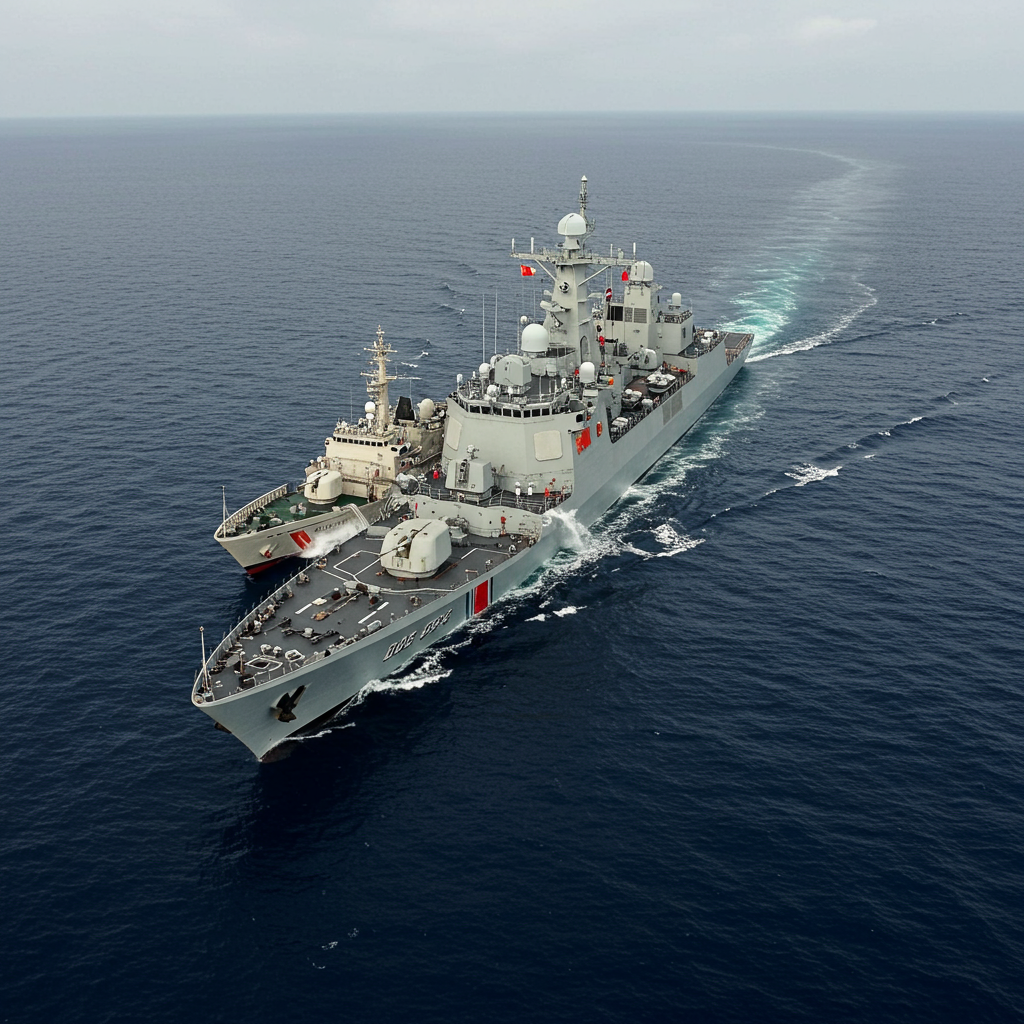A startling incident in the South China Sea has brought simmering regional tensions to a perilous new level. On August 11, 2025, near the contested Scarborough Shoal, two Chinese vessels — a modern guided-missile destroyer and a coast guard ship — collided during an aggressive pursuit of Philippine boats. This unexpected internal ramming, captured in dramatic footage by the Philippine Coast Guard, has been widely labeled a significant blunder for Beijing’s maritime operations. It starkly highlights the inherent dangers of increasingly confrontational tactics in one of the world’s most crucial waterways.
The collision sent shockwaves across diplomatic and defense communities. It wasn’t just an accident at sea; it was a visible manifestation of escalating brinkmanship. While China maintained its vessels were protecting its territorial claims, the incident underscored concerns about reckless maneuvers. Experts quickly pointed out how this “overkill” use of military force against civilian-aligned vessels could have led to a much more devastating international crisis.
The Fateful Encounter: What Unfolded at Scarborough Shoal
The confrontation unfolded near Scarborough Shoal, a disputed feature located approximately 140 miles west of the Philippine island of Luzon. On Monday, August 11, Philippine Coast Guard personnel were carrying out a humanitarian mission, distributing aid to Filipino fishermen in the area. This routine operation quickly escalated into a high-stakes pursuit.
According to Commodore Jay Tarriela of the Philippine Coast Guard, Chinese vessels initiated hazardous maneuvers. A China Coast Guard (CCG) vessel, identified as CCG 3104, began chasing the Philippine Coast Guard vessel BRP Suluan at high speed. The situation intensified when a People’s Liberation Army (PLA) Navy guided-missile destroyer, the 7,500-ton Type 052D ship Guilin (hull number 164), joined the pursuit.
Dramatic video footage released by the Philippine Coast Guard captured the precise moment of impact. The Guilin was seen careening into the CCG 3104. The collision left the China Coast Guard ship with substantial damage to its bow, rendering it “unseaworthy,” according to Philippine authorities. Visual analysis of the video revealed a heavily shattered bow on the CCG ship and significant dents on the Guilin‘s hull. At least three Chinese personnel were visible on the CCG 3104’s bow moments before the crash. While the BRP Suluan offered medical assistance, no response was received regarding potential Chinese casualties.
Unpacking the “Overkill”: Why a Destroyer?
The involvement of a highly advanced PLA Navy destroyer in a low-level maritime interdiction immediately raised eyebrows among analysts. Commissioned in 2021, the Guilin is designed for significant naval combat operations. It carries dozens of missiles intended for anti-air, anti-ship, and land-attack roles, forming a key component of Chinese aircraft carrier task groups.
Experts widely described the deployment of such a powerful warship in this scenario as “overkill.” Ray Powell, a South China Sea expert and director at SeaLight, called the destroyer’s involvement “highly unusual.” Collin Koh, a research fellow at RSIS in Singapore, echoed this sentiment. He noted that using a high-tech vessel for what is essentially law enforcement work is disproportionate. Typically, PLA Navy ships are expected to maintain an “over the horizon” posture, ready to support smaller China Coast Guard vessels only if they encounter serious trouble. In this specific incident, Powell observed at least seven China Coast Guard ships and 14 maritime militia vessels already present. This significantly outnumbered the four Philippine vessels involved, further underscoring the unusual nature of the Guilin‘s direct participation.
A Black Eye for Beijing’s Maritime Strategy
China’s official narrative of the incident sharply contrasted with the Philippine account. Beijing acknowledged a confrontation but conspicuously omitted any mention of a collision between its own vessels. Chinese Foreign Ministry spokesperson Lin Jian accused Manila of “seriously infringing upon China’s sovereignty and rights.” He stated that Chinese vessels were merely protecting what Beijing claims as its “inherent territory” in the South China Sea.
However, Philippine Chief of Staff General Romeo Brawner Jr. asserted that video evidence clearly showed the Guilin maneuvering to ram the BRP Suluan. He explained that the Philippine vessel successfully evaded the impact, leading the Chinese destroyer to instead collide with its own coast guard ship. Gen. Brawner explicitly stated that “China’s aggressive actions were very clear” and that they were “at fault because of their aggressive maneuvers.”
Analysts viewed the internal collision as a significant setback and embarrassment for the Chinese military. Carl Schuster, a former US Navy captain, suggested the Chinese ships were attempting a complex “sandwich” maneuver. The goal was likely to trap the Philippine cutter, force it to endure close-range water cannon blasts into its engine intakes, and potentially cripple it through a controlled bump. Schuster concluded that the maneuver “requires a lot of practice and coordination.” He implied that the Chinese crew lacked the necessary prerequisites, “and paid the price for it.” Alessio Patalano, a professor of war and strategy in East Asia, criticized the Chinese maneuver as exhibiting “no seamanship-like behavior,” calling it “highly unprofessional and dangerous.”
Escalation Risks: A Hair-Trigger Situation
The incident amplified long-standing fears about an accidental flashpoint in the volatile South China Sea. Experts widely agree that one miscalculation by a captain or pilot could trigger a much larger confrontation. Ray Powell emphasized the catastrophic potential: had the PLA destroyer struck the much smaller Philippine Coast Guard ship, it would have almost certainly resulted in injuries, fatalities, or even the sinking of the Philippine vessel.
Such an outcome could have dire consequences. Philippine President Ferdinand Marcos Jr. has previously stated that the death of a Filipino sailor in a similar incident could be deemed an “act of war.” The United States, a long-standing treaty ally of the Philippines, has repeatedly affirmed its “ironclad commitment” to the 1951 mutual defense treaty. American officials have pledged to defend the Philippines from any armed attack in the disputed waters, raising the specter of superpower involvement in a regional conflict.
Analysts like Powell believe that Beijing’s incentive structure for military officers tends to “bend toward aggression.” They point to past incidents, such as the 2001 collision involving a Chinese fighter pilot hailed as a national hero after his death in a crash with a U.S. Navy reconnaissance plane. This collision near Scarborough Shoal, with its display of highly aggressive and ultimately self-damaging behavior, serves as a stark warning. It suggests that safety distances and general maritime behavior are being pushed to dangerous limits.
A Pattern of Provocation: Prior Incidents in Contested Waters
The August 11 collision is not an isolated event. It forms part of an escalating series of dangerous skirmishes between China and the Philippines in the South China Sea over recent years. These confrontations highlight Beijing’s increasingly assertive posture and Manila’s resolve to protect its sovereign rights and traditional fishing grounds.
Notable past incidents include:
February 2023: The Philippine Coast Guard reported a Chinese ship deployed military-grade laser lights at the crew of the BRP Malapascua, approaching within 150 yards. This was condemned as a “blatant disregard for and a clear violation of Philippine sovereign rights.”
December 2024 (likely December 2023): Chinese coast guard vessels fired water cannons and sideswiped a Philippine government vessel during a maritime patrol near Scarborough Shoal. Beijing claimed its crew acted “in accordance with the law.”
June 2024: Filipino soldiers reportedly used “bare hands” to defend against Chinese coast guard personnel armed with swords, spears, and knives in the same area. This intense confrontation resulted in at least one Filipino soldier losing a thumb.
These recurring incidents underscore the precarious nature of maritime security in the South China Sea. The region, vital for global trade and rich in fishing resources, remains a potential flashpoint. Both sides continue to accuse the other of provocations, with each new confrontation raising the stakes and increasing the risk of a more serious, unintended conflict.
Frequently Asked Questions
What caused the Chinese ships to collide near Scarborough Shoal?
The collision occurred on August 11, 2025, when two Chinese vessels—a coast guard ship (CCG 3104) and a PLA Navy guided-missile destroyer (Guilin* hull number 164)—collided during a high-speed pursuit of Philippine Coast Guard and fishing boats. Philippine authorities stated the Chinese vessels were attempting aggressive maneuvers to block and expel their ships from the disputed Scarborough Shoal. Analysts suggest the collision was a result of a failed “sandwich” maneuver, indicating poor coordination and unprofessional behavior by the Chinese crews.
What is the significance of Scarborough Shoal in the South China Sea dispute?
Scarborough Shoal is a small, uninhabited triangular chain of rocks and reefs. While the Philippines considers it within its 200-nautical-mile exclusive economic zone (calling it Bajo de Masinloc) and a traditional fishing ground, China claims it as part of its Zhongsha Islands (Huangyan Island). China has effectively controlled access to the shoal since 2012, maintaining a constant coast guard presence. Its strategic location and rich fishing grounds make it a continuous flashpoint in the broader South China Sea territorial disputes, symbolizing the conflicting sovereignty claims.
How does this incident impact regional stability and the US-Philippines alliance?
This collision significantly heightens regional tensions by demonstrating China’s increasingly aggressive maritime tactics, including the deployment of high-tech naval assets for what are essentially law enforcement actions. It reinforces fears of miscalculation leading to open conflict. For the US-Philippines alliance, the incident underscores Washington’s “ironclad commitment” to its 1951 defense treaty with Manila, particularly given the Philippine President’s stance that a Filipino casualty in such incidents could be deemed an “act of war.” This puts the US in a difficult position, potentially compelling intervention if future confrontations escalate further, thus impacting broader Indo-Pacific security.
Conclusion
The collision between two Chinese vessels in the South China Sea serves as a stark reminder of the escalating risks in the hotly contested region. It was not merely an accident but a direct consequence of China’s increasingly aggressive and often reckless maritime tactics. The involvement of a sophisticated guided-missile destroyer in a civilian-oriented operation, coupled with the apparent lack of professional seamanship, highlights a dangerous trajectory in Beijing’s approach to its territorial claims.
This incident, coming on the heels of numerous other provocative encounters, brings the South China Sea closer to a potential flashpoint. The international community, particularly the United States with its treaty obligations to the Philippines, remains on high alert. Without a significant de-escalation of such confrontational behaviors, the risk of a serious miscalculation — one that could draw in global powers — continues to grow, threatening stability in one of the world’s most vital geopolitical regions.
Word Count Check: 1195 words




